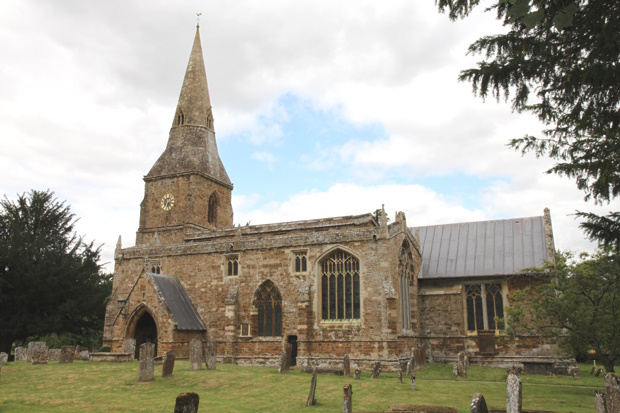


























St. Mary the Virgin, Broughton
In the grounds of the castle in Broughton is the parish church, the Church of St Mary the Virgin. The church consists of a chancel, nave, south aisle, and western tower surmounted by a broach spire. It dates almost entirely from the 14th century and contains some excellent work of that period. The circular font with its cablemoulding is the only evidence of a previous 12th century church, but the arcade of 4 arches which separates the nave from the south aisle appears to date from the mid-13th century, and indicates the addition of a south aisle at that time. Some fragments of 13th-century roll-mouldings were discovered during the 19th-century restoration and are preserved in the vestry. The existing nave, south aisle, and tower were probably built during the lifetime of Sir John of Broughton (d. 1315), and may be compared with contemporary work in other north Oxfordshire churches, notably Bloxham. There is a straight joint in the masonry between the tower and the body of the church, but this is probably to be regarded as a structural expedient to avoid the dangers of unequal settlement, rather than as evidence of any difference of date. The chancel is slightly more advanced in architectural character, and was evidently rebuilt at a slightly later date than the nave, probably in c. 1320–30. It is separated from the nave by a contemporary stone screen. Towards the end of the 14th century the walls of the south aisle were raised and clerestory windows were added. The original parapet and corbel table were re-used. When in the 15th century it was decided to add a nave clerestory, this heightening of the aisle walls made it necessary to raise the nave walls to an unusual height so that the nave clerestory might rise above the aisle roof. The main timbers of the existing low-pitched roof date from this rebuilding, though the roof has been frequently repaired, notably in 1684. Another 15th-century addition to the church was the large 5-light window in the south wall of the south aisle. Apart from the repair of the nave roof in 1684 few details have survived before the 19th century of any alterations to the fabric. It may, however, be noted that the altar rails were erected in 1637, the re-opening of the blocked west window of the south aisle was ordered in 1756, the south aisle clerestory was restored in 1819, and the spire was partly rebuilt in 1823. A small-scale general restoration took place in 1825, and in 1858 the sedilia and piscina, which had been walled-up until 1846 and whose tracery had been broken into a 'thousand atoms were restored'. Finally, between 1877 and 1880, a complete restoration was carried out. An open timber roof in the Gothic style replaced the flat (probably 18th-century) chancel roof of deal, the pitch being the same as that of the original medieval one; the nave roof was rebuilt, some of the original 15th-century beams being retained; the south clerestory wall was rebuilt from the window sills upwards; and the south aisle roof was entirely renewed and so constructed that it cleared the hood-mould and rear arch of the east window, which the original 14thcentury roof had not done. The mutilated east window of the chancel was restored to its supposed original height and new tracery in the Decorated style was inserted. The alterations also included the installation of a new pulpit in the Gothic style, replacing one made in 1741. Twentieth-century changes include the installation in 1908 of new heating apparatus and of electric light in 1939 and 1954. In 1906 the floor of the chancel was raised by two steps to its original level and a reredos was erected. The tower and spire were repaired in 1960. In 1944 a tapestry reredos was placed over the altar in the south aisle. In 1959 the 12th-century font was restored to its former position beside the westernmost pillar of the north nave arcade, its base and a draining hole in the ground having been found during recent restoration work. The church was richly furnished with wall paintings. At the restoration of 1878 many of these were uncovered, and others were discovered in 1938. The whole of the north wall of the chancel appears to have been painted with scenes from the life and death of the Virgin. Besides the chancel murals there was a Doom over the chancel arch, a crucifixion on the pier beside the font, and a St. Christopher on the north wall of the nave. The church was also once notable for its heraldic glass. Among the coats was that of the Wykehams. In 1963 only 3 circular panels of Elizabethan date survive in the cinquefoils of the tracery. Each has a quartered shield, including an achievement of Fiennes, wrongly reset. There are several examples of the work of Victorian glass-painters. The church has some notable monuments, of which 3 are medieval. They were considerably damaged, presumably during the Civil War, and were so zealously restored in 1846 that identification has been rendered difficult. Historical information about St. Mary's Church is provided by British History Online. 'Parishes: Broughton', in A History of the County of Oxford: Volume 9, Bloxham Hundred, ed. Mary D Lobel and Alan Crossley (London, 1969), pp. 85-102. British History Online http://www.british-history.ac.uk/vch/oxon/vol9/pp85-102 [accessed 13 January 2023]. St Mary's is a Grade I listed building. For more information about the listing see CHURCH OF ST MARY THE VIRGIN, Broughton - 1248778 | Historic England For more information about St. Mary's Church see Parishes: Broughton | British History Online (british-history.ac.uk) |

